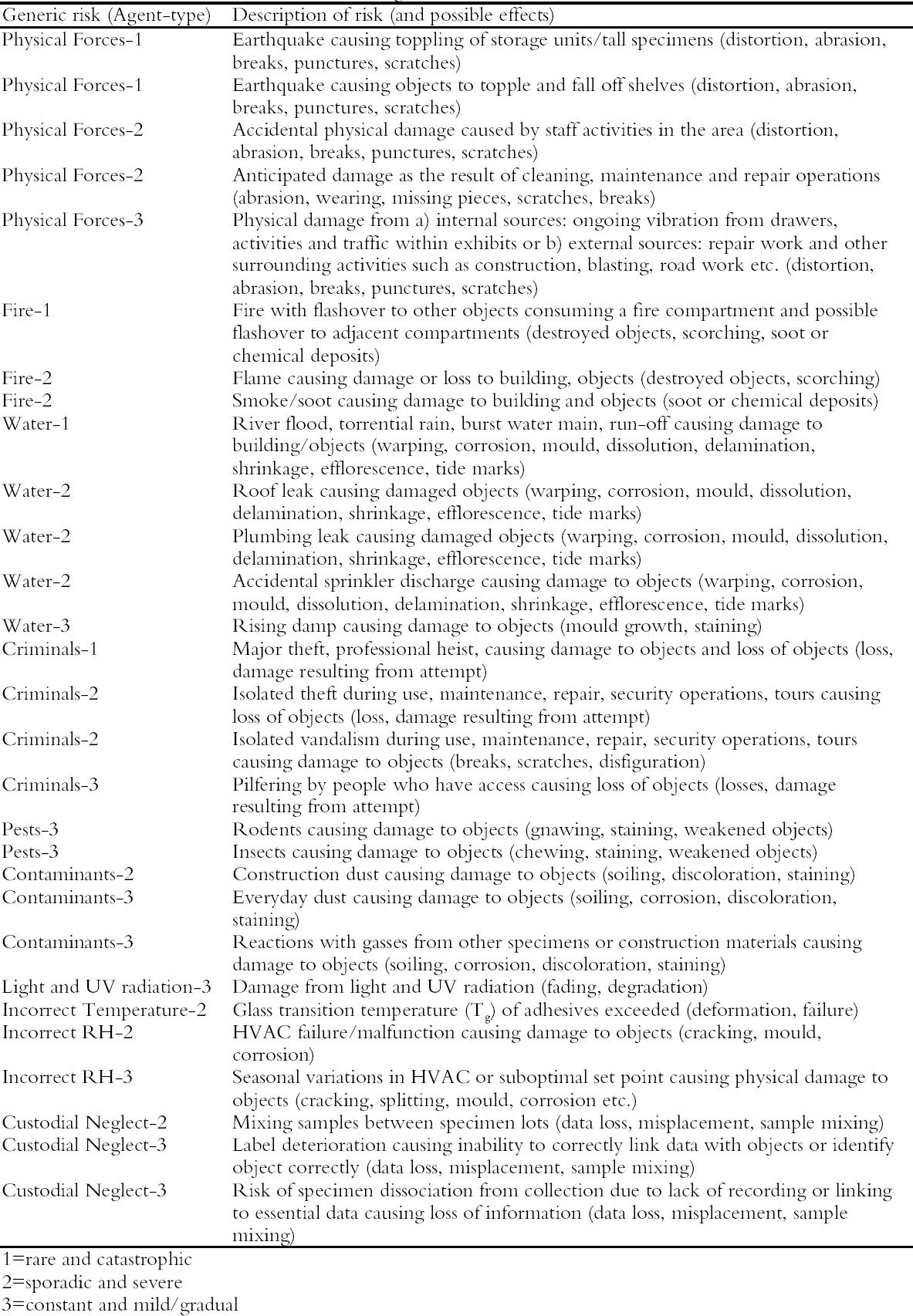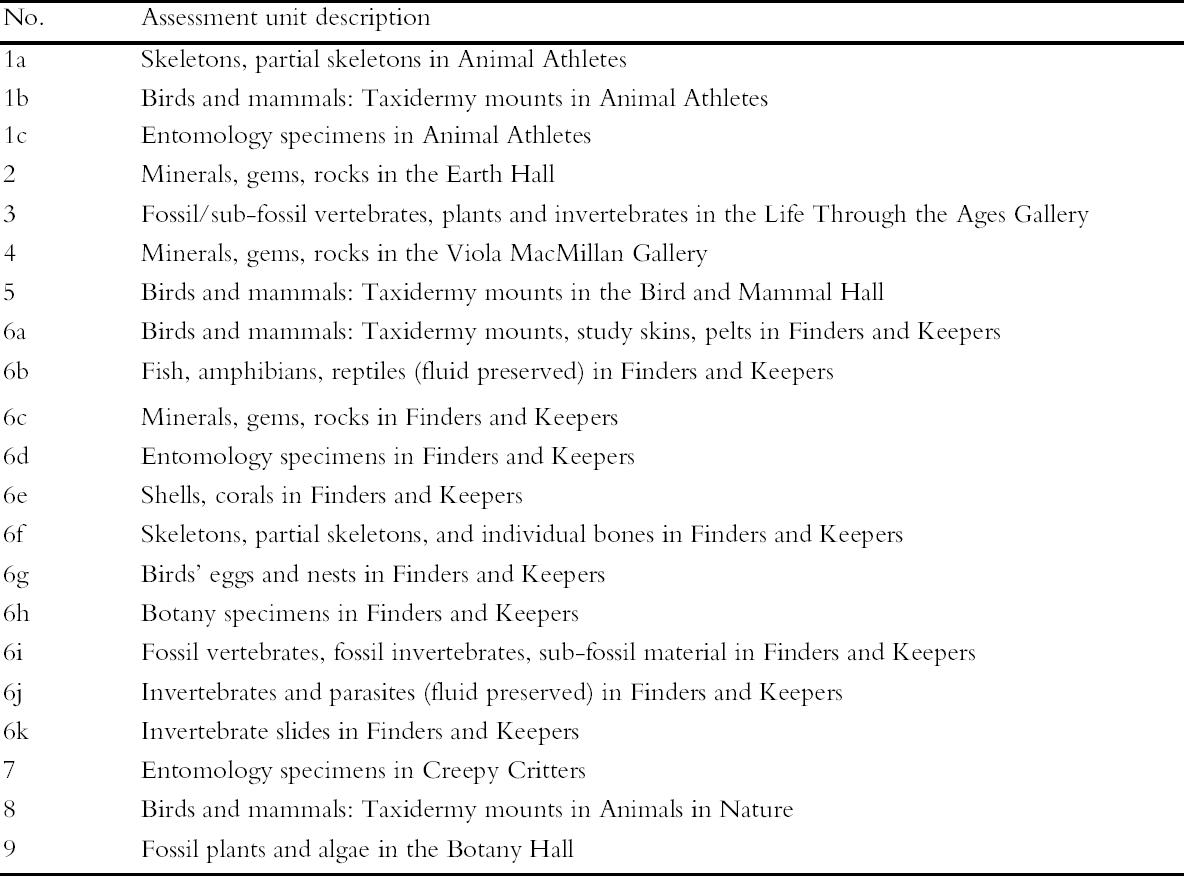RISK ASSESSMENT OF COLLECTIONS IN EXHIBITIONS AT THE CANADIAN MUSEUM OF NATUREGARNET MUETHING, ROBERT WALLER, & FIONA GRAHAM
2 METHODRisk assessment involved defining the scope of the assessment, identifying all the risks to collections, quantifying those risks to determine their severity in terms of loss to the collection as a whole, and then comparing the risks to arrive at priorities. These priorities informed the planning for projects such as the VMMB Renewal Project. The assessment included all CMN collection material in VMMB exhibits, a total of 1498 specimens. The VMMB currently houses a number of live plants and animals in aquariums and terrariums; for the purposes of the assessment nothing live or borrowed from other institutions was included. The assessment was based on current conditions (i.e., not taking into account renovation plans) in order to identify current risks which could then be addressed during the renovation project. The risk assessment was done using the Cultural Property Risk Analysis Model (CPRAM; Waller 2003). Threats to the collection were identified first by consulting a list of generic risks. Generic risks are based on agents of deterioration (Michalski 1990) combined with a type of risk (Waller 1994). Three types of risk are distinguished by their frequency and severity of occurrence. They are 1-rare and catastrophic, 2-sporadic and severe, and 3-constant and mild/gradual. Generic risks were subdivided into a number of specific risks, in order to achieve a comprehensive list of risks to the collection (table 1). Within exhibits, specimens were grouped into units according to material and taxonomic group (table 2). The 29 specific risks were assessed individually for each of the 21 collection units. Once risks had been identified and collection units had been defined, variables were estimated for each risk. The CPRAM has identified four variables to be used in risk estimation. The variables are fraction susceptible (FS), loss in value (LV), probability (P), andextent (E). Each of these variables is a simple ratio and is between 0 and 1, inclusive. They are explained in general terms below. The fraction susceptible is the fraction of the collection being assessed that is susceptible to the risk being considered. The loss in value is the expected loss in value to the collection as a result of the risk being considered. Probability is the likelihood, based on our best current knowledge, of a type 1 risk event occurring over the next century. Extent applies to type 2 and 3 risks and is the degree of damage or loss to the collection expected to occur over the next century. Each variable had to be determined or estimated for every identified specific risk. In order to arrive at realistic estimates for variables it was necessary to hold interviews and meetings with staff from a number of areas within the museum. Staff from Collections, Research, Facilities, Exhibits, and Security gave information based on their experience with the collections and exhibits at the VMMB. Interviews with staff usually began with a preliminary discussion of the risks being assessed and the identification of the various factors influencing those risks. Once the main factors had been identified, each risk was examined in more detail. For example, for the risk of accidental sprinkler discharge in an exhibit, factors such as the type, number and location of sprinklers in the area, the quantity of water each sprinkler would discharge per minute, the expected response time and emergency response procedures in place, the number and type of specimens in the area, and the type of display cases that specimens are in were all discussed. “What if” scenarios were often used to facilitate these discussions: What is the longest possible time the sprinklers could discharge before response? What is the shortest time? How much value would this type of specimen lose if it were damaged by water? Other information captured during these interviews included monitoring records, exhibit design plans, experiential knowledge, observations, as well as anecdotal information passed on from previous staff. In addition to enabling us to make realistic estimates of risk, this stage of the assessment served to increase awareness of the risks to the collection for all staff involved. To ensure consistency in estimates and avoid subjective judgments, a facilitator collected and reviewed all of the information from staff. The information was then discussed by the Conservation
After all variables were estimated, magnitudes of risk (MR) were calculated for all risks using the equation MR = FS xLV xP xE. Where more than one specific risk was assessed for the same type (for example in table 1, Criminals 2-Theft and Criminals 2-Vandalism) the magnitudes of risk were added to give the generic risk total. The magnitudes of assessed risks were compared to rank the risks by severity. As a result of this ranking seven high-priority risks were identified. |

